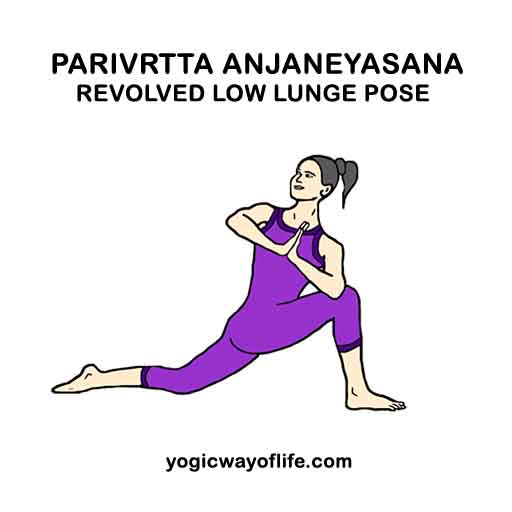Parivrtta Anjaneyasana or the Revolved Lunge Pose is a variation of Anjaneyasana or the low lunge pose. In Sanskrit, Parivrtta means revolved or twisted, Anjaneya is a legendary god Hanuman from the epic Ramayana and Asana means a pose. Parivrtta Anjaneyasana strengthens the abdominal muscles, the hip and thigh muscles and improves the sense of balance.
How to do Parivrtta Anjaneyasana?
- Parivrtta Anjaneyasana can be started from various poses but the easiest one is the Adho Mukha Svanasana or the downward facing dog pose. In this pose, you are on the floor supported by your feet and the palms. The hips are raised up straight forming an angle with the hands and legs.
- Start in Downward Facing Dog Pose. Exhale and take your right foot forwards. Bend lower to make the right knees align with the right foot. The left lower leg including the left knee can be on the floor giving support. At this stage you will feel a good stretch in the left thighs and groins.
- Inhale slowly and raise your torso up. At the same time, raise both your hands up above the head. The palms can touch each other in Anjali Mudra in the raised position. The front knee should be aligned with the ankles. Tilt your head slightly backwards and look up. This is the basic Anjaneyasana or the Low lunge Pose.
- From Anjaneyasana, we move on to Parivrtta Anjaneyasana. Turn or twist the body to the right and let the elbows rest on the right knees. Or the elbows can also touch the side of the knees.
- Raise the head and gaze slightly upwards and sideways.
- Remain in this position for as long as you are comfortable. The left knees touching the floor will give a better balance and one can do this pose without strain. One can hold the breath in the final position or you can breathe slowly and normally.
- This can be repeated on the left side too.
Benefits of Parivrtta Anjaneyasana
- Parivrtta Anjaneyasana quadriceps and gluteus muscles.
- It strengthens and stretches the abdominal muscles which tones the organs in the abdomen and improves digestion.
- It improves the sense of balance. In the pose, the knee touches the floor, making it easy to maintain balance.
Contraindications for Parivrtta Anjeneyasana
- Those with any knee or hip injury should not do Parivrtta Anjaneyasana.
- Also avoid if you have any spine or neck injury

